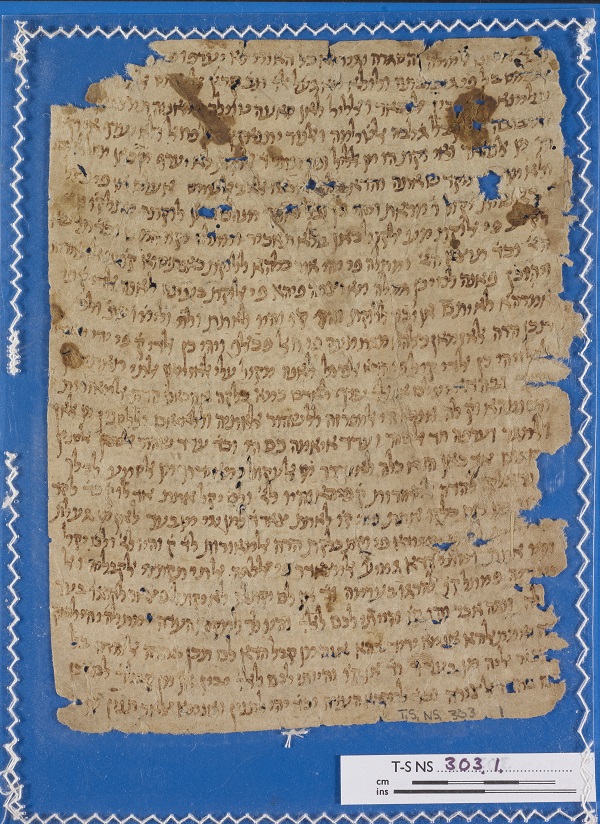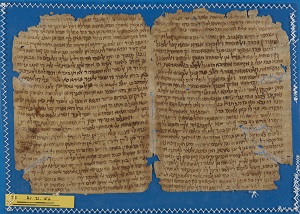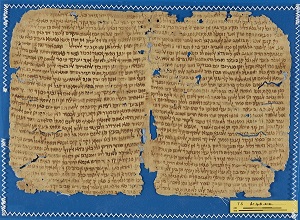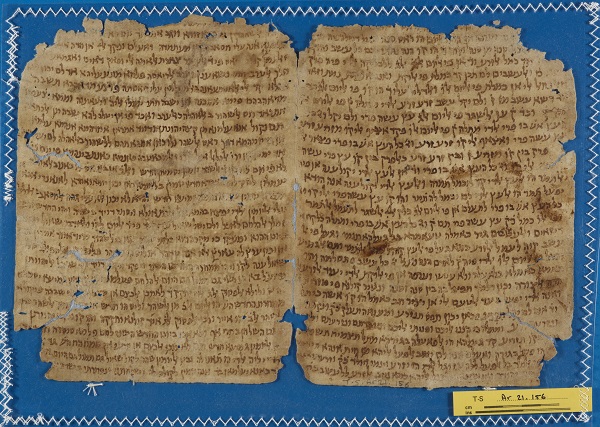Saadya Gaon’s Refutation of Anan or a Qaraite Book of Commandments? T-S Ar.21.156, T-S Ar.48.216 and T-S NS 303.1
Saadya b. Joseph al-Fayyūmī, better known as Saadya Gaon (882–942 CE), was the most important and influential scholar of Judaeo-Arabic culture in the 10th century. Saadya produced a vast body of writings in philosophy, liturgy, grammar, Bible translation and exegesis, religious law, calendar and calendar polemics, etc. Despite their considerable importance, many of Saadya’s works have not been preserved in complete copies and must be identified and reconstructed from manuscript fragments and quotations in other works. Such reconstructions form the basis of, for example, Saadya’s published commentaries on Genesis and Exodus.1 The attribution to Saadya of unidentified Genizah fragments is guided by quotations in other sources, textual and conceptual parallels, stylistic features, etc. Despite this, it sometimes remains conjectural.
Among recent reconstructions of Saadya’s works is Yehuda Seewald’s publication of Saadya’s polemical treatise Refutation of Anan.2 This work, composed when Saadya was 23 years old, targets Anan b. David, the 8th-century Babylonian founder of the Ananite movement (Anan b. David was later unhistorically adopted as the founder of Qaraism).3 Very little material is preserved that can be attributed to the Refutation of Anan with certainty. A fragment in the Lewis-Gibson collection (L-G Glass 16) closes with a poem that attributes it to Saadya’s Refutation of Anan.4 This fragment contains a defence of the rabbinic tradition. In addition, Saadya referred to the Refutation of Anan at least twice in his Bible commentaries.5 These references demonstrate that the Refutation of Anan also dealt with questions of the calendar. While the Rabbanite calendar in the 10th century was based on a calculation, Qaraites set months by sighting the lunar crescent and intercalated years (i.e. added an extra 13th month) on the basis of the state of ripening of barley crops, known as aviv. They argued that this was commanded in the Bible and has always been the Jewish practice. This stance elicited a strong polemical response from Saadya who famously claimed that the Jewish calendar has been always set by a calculation.
Among the manuscripts identified by Seewald as belonging to the Refutation of Anan are four fragments copied in the same hand that deal with the Qaraite calendar and calendar polemic: T-S Ar.21.156, T-S Ar.48.216, T-S NS 303.1 and University of Pennsylvania, Halper 450.6 Seewald believed that these fragments constitute a large portion of the calendar section of the Refutation of Anan. However, as I read the fragments, it became immediately clear to me that this identification is untenable. In fact, T-S Ar.48.216, T-S NS 303.1 and most of T-S Ar.21.156 correspond nearly verbatim to the Book of Commandments of the Qaraite scholar Sahl b. Maṣliaḥ, active in Jerusalem in the middle–second half of the 10th century.7 Like the majority of Sahl’s writings, the Book of Commandments is still unpublished but I had the occasion to work on it in the course of a recently completed project on the Qaraite calendar.8 Sahl b. Maṣliaḥ’s Book of Commandments contains among other topics extensive discourses on the new moon and aviv barley. These discourses are fragmentarily preserved in the Firkovitch Collection in the Russian National Library, manuscripts RNL Evr Arab I 819, RNL Evr Arab I 823 and RNL Evr Arab I 3315 (these manuscripts are parts of the same original codex).
Correspondences between the fragments identified by Seewald as Saadya’s Refutation of Anan and Sahl b. Maṣliaḥ’s Book of Commandments are as follows. Halper 450 and T-S NS 303.1 which directly follows it, are on the new moon. They discuss Genesis 1:14 וַיֹּאמֶר אֱלֹהִים יְהִי מְאֹרֹת בִּרְקִיעַ הַשָּׁמַיִם לְהַבְדִּיל בֵּין הַיּוֹם וּבֵין הַלָּיְלָה וְהָיוּ לְאֹתֹת וּלְמוֹעֲדִים וּלְיָמִים וְשָׁנִים, with a particular emphasis on how the luminaries separate the day from the night and why the Scripture says וְהָיוּ לְאֹתֹת rather than וְהָיוּ אֹתֹת. They also give definitions of evening, morning, day, month, and year and discuss the time and place in the sky where the luminaries were created on day four. Not all of the text in Halper 450 and T-S NS 303.1 is preserved in the Firkovitch Collection copy, which is lacunose, but the bottom of T-S NS 303.1r and the entire T-S NS 303.1v correspond verbatim to RNL Evr Arab I 819, fols 1v–1r (in this order).

T-S NS 303.1 recto
T-S Ar.21.156 and T-S Ar.48.216 are from the beginning of Sahl’s discourse on the aviv. This discourse begins on T-S Ar.21.156v right with an elucidation of the meaning of “observation” (šemira) in “observe the month of aviv” (Deuteronomy 16:1). It continues with a discussion of the time when aviv barley must be found, and finally talks about the stage in the ripening of barley that is called aviv. The time and “quality” (i.e. the stage of ripening) of aviv barley were controversial topics in Qaraite calendar literature. This explains why T-S Ar.21.156 and T-S Ar.48.216 have a polemical feel noted by Seewald: in them the opinion is defended that in order to declare that the month following Adar is Nisan (and not the second Adar) barley must be yellow in or before the beginning of the month, while other opinions are refuted. This polemic is strictly intra-Qaraite, rather than Rabbanite-Qaraite. T-S Ar.21.156 and T-S Ar.48.216 represent the two inner bifolios of the original quire, whereby T-S Ar.48.216 belongs between the folios of T-S Ar.21.156. T-S Ar.21.156v right–T-S Ar. 48.216v right correspond to RNL Evr Arab I 823, fols 22r–23v, 2r–2v and RNL Evr Arab I 819, fol. 12r. The text in T-S Ar. 48.216v right, bottom–T-S Ar.21.156v left is not preserved in the surviving manuscripts of the Book of Commandments known to me, but is found in its Abridgement, RNL Evr Arab I 800, fols 1v–3r. T-S Ar.21.156v left bottom–T-S Ar.21.156r right correspond to RNL Evr Arab I 3315, fols 1r–1v.9
T-S Ar.21.156 verso 
T-S Ar.48.216 recto 
These correspondences amply demonstrate that Halper 450, T-S NS 303.1, T-S Ar.21.156 (starting from verso right) and T-S Ar.48.216 belong to Sahl b. Maṣliaḥ’s Book of Commandments and not to Saadya Gaon’s Refutation of Anan. A complication is presented by the first page of T-S Ar.21.156 (recto left). This page contains Saadya’s arguments in favour of his theory that the Jewish calendar has always been calculated. The bulk of the page is given to the story of David and Jonathan (1Samuel 20) who knew in advance when it would be the new month and, in Saadya’s view, observed two days of roš ḥodeš. According to Saadya these practices are attested only in the Rabbanite calculated calendar and prove that it was used already in Biblical times. The story of Anan’s calendar dissent is also included: the observational calendar – so Saadya – was introduced by Anan for the sole purpose of achieving his political goals. Anan hoped to become the Exilarch but was passed over. He then turned to Muslim authorities for support and adopted some Muslim practices, including lunar observation, in order to find favour with the Muslims. Arguments for the calculated calendar continue overleaf for the first four lines of T-S Ar.21.156v right and are then directly followed by Sahl’s discourse on the aviv. It is difficult to explain the presence of Saadya’s arguments, without a refutation, in the middle of a Qaraite Book of Commandments. No such passage is found in the surviving fragments of Sahl’s Book of Commandments although Saadya’s other arguments are brought up and refuted. Instead, these particular arguments, nearly identically worded, are cited in Sahl’s Commentary on Exodus,10 which contains a long dispute against Saadya on the topic of the Oral Law. In the commentary the arguments are presented as quotations, although it is not clear from which one of Saadya’s works (the beginning of the commentary has not survived). This makes it probable that T-S Ar.21.156r left indeed represents Saadya’s text – the only page of a set of four fragments identified by Seewald as the Refutation of Anan.

T-S Ar.21.156 recto
The significance of this story goes beyond the more accurate identification of four Genizah fragments and the removal from the Saadyanic corpus of a text that Saadya did not write. It demonstrates how important it is to edit and thereby make accessible works that have been securely identified. Among other things, such editions have the power to prevent avoidable mistakes and become stepping stones to an accurate identification of works assumed lost.
Research for this FOTM was carried out in the framework of the project “Saadya Gaon’s works on the Jewish calendar: Near Eastern sources and transmission to the West” (UCL–LMU), funded by the Fritz Thyssen Foundation.
Footnotes
1 Zucker, M., 1984, Saadya’s Commentary on Genesis, New York: Jewish Theological Seminary of America [Hebrew]. Ratzaby, Y., 1998, Rav Saadya’s commentary on Exodus, Jerusalem: Mossad Ha-Rav Kook [Hebrew]. See also Kafiḥ, Y., 1963, Perushe Rabenu Saʿadyah Gaon ʿal Ha-Torah, Jerusalem: Mosad Ha-Rav Kook.
2 Seewald, Y., 2016, ‘Kitāb al-Radd ʿalā Anan by Rav Saadia Gaon,’ Qovetz Hitzei Giborim 9, 1–80 [Hebrew].
3 Poznanski, S., 1898, ‘The anti-Karaite writings of Saadiah Gaon,’ The Jewish Quarterly Review 10/2, 238–76, pp. 241–244. Malter, H., 1921, Saadia Gaon: His Life and Works, Philadelphia: Jewish Publication Society of America, pp. 261–263, 380. Brody, R., 2013, Saʿadyah Gaon, tr. B. Rosenberg, Oxford: Littman Library of Jewish Civilization, p. 147.
4 Lewin, B.M., 1934, ‘Kitāb al-Radd ʿalā Anan’, Ginzei Qedem 5, pp. 147–152 [Hebrew]. Seewald, ‘Kitāb al-Radd’, p. 11. Seewald correctly identified BL Or 5554B.32–33 as belonging to the same manuscript and directly joining L-G Glass.16.
5 These passages were quoted by the Qaraite exegete Yefet b. Eli and published by S. Poznanski (‘The anti-Karaite writings’, pp. 241–242).
6 Seewald, ‘Kitāb al-Radd’, p. 12. Seewald published T-S Ar.48.216 and most of T-S Ar.21.156, leaving the rest of T-S Ar.21.156, T-S NS 303.1 and Halper 450 for later (ibid, p. 30 n. 77.). Another fragment in the same hand identified by Seewald is T-S Ar.36.70, which he included in the edition despite expressing doubts if it was, indeed, a part of Saadya’s polemic or a Qaraite work on calendar (ibid, p. 30, n. 76). In my view, this fragment belongs to a Qaraite work: its recto contains a distinctly Qaraite discussion of the time when aviv barley must be found in order to declare Nisan; on verso rabbinic interpretations of two Biblical verses are judged to be a useless innovation (see Seewald’s edition and translation on pp. 38–39, 56–58).
7 Goldstein, M., ‘Sahl (Abū ʾl-Sarrī) ben Maṣliaḥ’, in: Encyclopedia of Jews in the Islamic World, Executive Editor Norman A. Stillman. Consulted online on 24 January 2022. Leon Nemoy, Karaite Anthology: Excerpts from the Early Literature (New Haven: Yale University Press, 1952), pp. 109–111.
8 ‘Qaraite and Rabbanite calendars: origins, interaction, and polemic’ (UCL–LMU), funded by the Fritz Thyssen Foundation.
9 It is possible that the Firkovitch manuscripts represent a revised and extended version of Sahl b. Maṣliaḥ’s Book of Commandments. Indeed, all text in T-S NS 303.1, T-S Ar.21.156 (starting from verso right) and T-S Ar.48.216 is found in the Book of Commandments as preserved in the Firkovitch Collection. However, in places the Firkovitch manuscripts carry a longer version than the Genizah fragments: usually short phrases or 1–2 sentences are added, although in one case the addition is substantial.
10 RNL Evr Arab I 1166, fols 16r–17r and 5r–5v respectively.
Cite this article
Vidro, Nadia. 2022. "Saadya Gaon’s Refutation of Anan or a Qaraite Book of Commandments? T-S Ar.21.156, T-S Ar.48.216 and T-S NS 303.1." Taylor-Schechter Genizah Research Unit. doi:10.17863/CAM.99638.
If you enjoyed this Fragment of the Month, you can find others here.
Contact us: genizah@lib.cam.ac.uk
The manuscripts in this article are part of the Cairo Genizah Collection in Cambridge University Library. To see more items from this collection visit: https://cudl.lib.cam.ac.uk/
